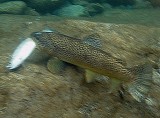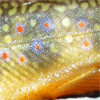REALTIME FLOWS  U. Kern: n/a cfs
U. Kern: n/a cfs
 L. Kern: 1341 cfs
L. Kern: 1341 cfs
 E.W: 312 cfs
E.W: 312 cfs
 U. Owens: 108 cfs
U. Owens: 108 cfs  L. Owens: 496 cfs 09/02/19 1:15 PM PST
L. Owens: 496 cfs 09/02/19 1:15 PM PST
Question for ultralight guys
14 posts
• Page 1 of 1
Question for ultralight guys
What do you use for your line to leader connections on your 1wt and smaller lines? I recently picked up 2nd hand SLT 0 and 1 weights. The 0 is a center axis and came with a line (Sage Quiet Taper II DT), and I have an older but unused Orvis Wonderline WF 1, but neither of these lines have a built in loop at the end. I pretty much exclusively use the Rio tapered leaders, and on my other lines without a built in loop I use those mesh type loop connectors (though I forgo the shrink wrap, in favor of a bit of superglue). However, I've heard it hypothesized that those are too robust for the smaller line weights, and adversely affect leader turn over. What say ye?
-

buggravy - Posts: 171
- Joined: November 26th, 2008, 11:55 am
- Location: Calabasas, CA
Re: Question for ultralight guys
buggravy wrote:What do you use for your line to leader connections on your 1wt and smaller lines? I recently picked up 2nd hand SLT 0 and 1 weights. The 0 is a center axis and came with a line (Sage Quiet Taper II DT), and I have an older but unused Orvis Wonderline WF 1, but neither of these lines have a built in loop at the end. I pretty much exclusively use the Rio tapered leaders, and on my other lines without a built in loop I use those mesh type loop connectors (though I forgo the shrink wrap, in favor of a bit of superglue). However, I've heard it hypothesized that those are too robust for the smaller line weights, and adversely affect leader turn over. What say ye?
I was JUST looking at the braided leader ends at Sports Chalet, and the 3-7wt one might be a bit heavy duty for a 0wt... but you could also consider makining it super short and using that.
the other idea I would say would be the Dave Whitlock Zap-a-Gap leader connection to connect the butt section directly to the flyline... Its not very convenient for changing though, and I haven't tried it yet only because I love the furled leader and I'm not sure it would work on that at all.
I don't know about the "Ultralight" stuff much, (i fish a 3wt), but for Dry flies (especially) and shallower nymph/wet presentations, you may want to try a Furled leader, I finally wore mine out this weekend and it lasted me about a half a season, but I love the fact that it basically has zero memory, and doesn't really tangle.
Fishing is the most wonderful thing I do in my life, barring some equally delightful unmentionables.
http://www.adiposefin.com
http://www.adiposefin.com
-

rayfound - Posts: 2401
- Joined: September 11th, 2008, 11:11 pm
- Location: Riverside, ca
Re: Question for ultralight guys
I used to put a mesh loop on the end and do a loop-to-loop with the leader (looped), but it would always get jammed in the guides at the tip. I've since switched to the nail knot, which is smaller. Another option (Mike's way) is to nailknot a section of mono leader (maybe the butt 6-8" of a 5x leader) to the flyline and then loop the end of the mono tip. The simple nail knot works well, methinks...
Joe
Joe
Slap a cold trout on it!
-

Sheriff Joe - Posts: 393
- Joined: March 1st, 2008, 5:42 pm
- Location: Longmont, CO
Re: Question for ultralight guys
Nail knot to a small butt section and make a loop so I can do a loop to loop connection with the leader. Depending on where I am fishing I will use different leaders. For example if I am on the "O" I use 4 or 5X on my 1WT. If I am on my preferred waters I use 7X on my 1 and 000WT rods. But this is just how I like to do it, I know plenty of people that hate loop to loop connections.
-

Sasha - Posts: 3885
- Joined: July 11th, 2008, 10:42 pm
- Location: The 208
Re: Question for ultralight guys
My lightest rods are 2wts (I am getting ready to start the build on my second 2wt). I use a Rio Selective Trout 2, DT2F line. To the end of that, I have nail knotted a short length of 20 lb. mono, which I then tied a perfection loop in the end of. This is then loop to loop connected to the leader. The length of the connecting mono is about 3 inches. It is actually a piece from the butt end of an old leader that I was getting rid of. This allows it the match, pretty closely, the stiffness of the leaders I am tying into it. I used to do the same with Amnesia mono, but found it to be too limp compared to the leaders I buy. It did not allow the energy to transfer from line to leader properly.
Oh, by the way, I still carry small sections of Amnesia mono with perfection loops in each end. I will put them between line and leader as an indicator when nymphing.
Oh, by the way, I still carry small sections of Amnesia mono with perfection loops in each end. I will put them between line and leader as an indicator when nymphing.
How do you tie the fly to your hooks without killing them with the thread? I keep cutting them in half.
-

darrin terry - Posts: 3369
- Joined: July 26th, 2008, 8:47 am
- Location: Locale: NoCal
Re: Question for ultralight guys
I've seen a post on another forum about a technique to make a welded loop. The guy used 1/8" clear heat shrink tubing. After the shrink the clear shrink tubing was removed leaving and a perfect welded loop in the line. I think Gary C on here may have made the post.
Andy
Andy
-

DubL HauL - Posts: 1154
- Joined: July 27th, 2008, 5:07 pm
Re: Question for ultralight guys
I use a furled leader... if the line does not have a welded loop - I use 15 pound mono and tie a nail know holding the furled leader to the fly line - with some knot sense (same as above product)
I prefer furled leaders because I use one leader for over a year... just go through a lot of tipit.
I get my furled leaders from "the bulk mailer" just google it. comes is custom sizes.
I prefer furled leaders because I use one leader for over a year... just go through a lot of tipit.
I get my furled leaders from "the bulk mailer" just google it. comes is custom sizes.
2010: Fishing days 19
The things you own end up owning you. It's only after you lose everything that you're free to do anything. ~Fight Club
The things you own end up owning you. It's only after you lose everything that you're free to do anything. ~Fight Club
-

castaway - Posts: 627
- Joined: September 2nd, 2008, 5:59 pm
Re: Question for ultralight guys
For the record you can find the mesh loop connectors for smaller diameter line as well. A shop here in Diego carries one for line weights 1-3.
chris
chris
-

mtnguru - Posts: 305
- Joined: September 12th, 2008, 1:06 pm
- Location: San Diego
Re: Question for ultralight guys
I have a decent of amount of on stream use and experimentation with leaders for my TXL 00wt and another 1 wt.
My method: I nailknot to the end of the fly line. I am nto a fan of the loop to loop and the welded loops or meshed loops for these UL rods because of annoying tangling and a "weighted" down feelign when casting.
I also exclusively tye my own leaders for all of my rods--expecially my UL's. This way, I can come to a specially tailored leader that fits the context of the fishing to be done and the way the rod casts.
More often than not I utilize Gary Borger style leaders as I find that they are simple to tye on stream and they do the trick for me! Here's an intro to those http://www.rackelhanen.se/eng/10058.htm
I generally am fishing small creeks and streams with my 00; thus, I employ a very short leader, e.g. around a 5-7' tapering down to 7X. I can't remember the formula that I devised for this style leader, but I will try to post it later as I am at work.
My method: I nailknot to the end of the fly line. I am nto a fan of the loop to loop and the welded loops or meshed loops for these UL rods because of annoying tangling and a "weighted" down feelign when casting.
I also exclusively tye my own leaders for all of my rods--expecially my UL's. This way, I can come to a specially tailored leader that fits the context of the fishing to be done and the way the rod casts.
More often than not I utilize Gary Borger style leaders as I find that they are simple to tye on stream and they do the trick for me! Here's an intro to those http://www.rackelhanen.se/eng/10058.htm
I generally am fishing small creeks and streams with my 00; thus, I employ a very short leader, e.g. around a 5-7' tapering down to 7X. I can't remember the formula that I devised for this style leader, but I will try to post it later as I am at work.
- dna
- Posts: 217
- Joined: July 26th, 2008, 4:49 am
- Location: The Big City, CA
Re: Question for ultralight guys
Lots of good suggestions. I'd actually tried the nailknot/mono/perfection loop set up on a 2 wt before, and found it a bit cumbersome. In retrospect though I think I used a mono that was too stiff, and made my loop too large. Might try to revisit this set up. Thanks all!
-

buggravy - Posts: 171
- Joined: November 26th, 2008, 11:55 am
- Location: Calabasas, CA
Re: Question for ultralight guys
buggravy wrote:Lots of good suggestions. I'd actually tried the nailknot/mono/perfection loop set up on a 2 wt before, and found it a bit cumbersome. In retrospect though I think I used a mono that was too stiff, and made my loop too large. Might try to revisit this set up. Thanks all!
It's worked well for my current 2wt, but the one I am getting ready to build will have much smaller guides. The mfg recommended: Tip top - Stripper - 3.5, 2, 2, 2, 3, 3, 4, 4, 12mm. However after talking it over with Mike at Snake Guides, I am going with: again Tip top - Stripper - 4.0, 1/0, 1/0, 1/0, 1, 1, 2, 3, 9mm.
I might be time to find a new leader setup for my 2wt rods.
How do you tie the fly to your hooks without killing them with the thread? I keep cutting them in half.
-

darrin terry - Posts: 3369
- Joined: July 26th, 2008, 8:47 am
- Location: Locale: NoCal
Re: Question for ultralight guys
buggravy wrote:Lots of good suggestions. I'd actually tried the nailknot/mono/perfection loop set up on a 2 wt before, and found it a bit cumbersome. In retrospect though I think I used a mono that was too stiff, and made my loop too large. Might try to revisit this set up. Thanks all!
Try skipping the perfection loop and just blood knot a tapered leader to the butt section. It's a little smaller, and cleaner connection. I don't know how many times you change tapered leaders, but I try to get as much use out of one as I can. If I change my tapered leaders on my 0 or 2wts a couple times a years, I have plenty(blood knots don't use much material)of butt section to do that. Once the butt section gets too short, I snip it off and start over.....but I usually change the fly line before that happens.
The Whitlock connection Ray suggests sounds like the ideal connection to me. Very slim, non cumbersome splice. I would think it would be the stealthiest connection to use.
briansII
-

briansII - Posts: 4902
- Joined: September 3rd, 2008, 12:39 pm
- Location: Central Ca.
Re: Question for ultralight guys
http://flyfisherman.com/skills/dwnoknot/index1.html
For what its worth - I haven't actually tried this, but I think I will on my next furled leader... it might be a challenge.
Also, I see no reason why someone needs this fancy pin vise... I'll be using Vice Grips.
Fly Fisherman Magazine wrote:Uncoil a knotless, tapered leader and straighten the butt section. If the leader butt does not have a loop, tie a simple overhand knot in it 1 inch from butt end. This provides a convenient handle for one of the cementing steps. Cut the fly-line tip with nippers so it is square and smooth.
1. Insert the needle point into the pin vise so that about 1/2 inch of the eyed end of the needle sticks out. Hold the fly-line tip tightly between your thumb and index finger so only about 1/16 inch sticks out. This will keep the line stiff so the needle can be easily inserted.
2. Set the eye of the needle against the tip of the fly line, and with a gentle back and forth drilling motion of the pin-vise, push the needle inside the fly-line core about 3/8 inch and out the line. Pass the tip of the leader through the needle eye. Stop when there is an inch of leader through the eye. If the leader tip is too large, shave it with a sharp razor blade so that it passes through the needle eye.
3. While holding the fly-line tip in your fingers, pull the pin vise back to remove the needle from inside the fly line. This threads the leader through the fly line. Keep pulling to remove the leader tip from the needle eye. Pull the leader forward through the fly-line tip until only about 2 inches of the butt section sticks out the side of the line tip.
4. (a) With a 3/8-inch-wide strip of 100-grit sandpaper, roughen a small section of the leader 1 inch in front of the fly-line tip. (Be sure not to roughen the leader section sticking out the side of the fly line.) Important: Make sure this sanded area looks opaque and feels rough. (b) Apply a small amount of Zap-A-Gap to the sanded area. (c) With your thumb and index finger, hold the fly-line tip right behind where the leader exits the side of the fly line. With your other hand, pull on the leader butt that is sticking out the side of the fly line with a smooth, fairly quick motion to pull the entire roughened section inside the fly line. As soon as the leader slides into the fly line, the cement sets. Note: Practice this step several times without cement. If you pull too fast, the entire roughened area passes through the fly line. Pull too slowly and only the front edge of the rough area ends up inside the fly line.
5. (a) Cut all the leader sticking out of the side of the fly line without cutting the fly line itself. (b) Place a small amount of Zap-A-Gap over this exit hole. This seals the hole and strengthens the coating to prevent hinging. (c) Grab the line and leader about 6 inches from the connection and make a quick, strong pull at the same time on both. This stretches the fly line and tucks the cut leader end inside the fly line. If you still have a bend in the fly line at the connection, fold it in the opposite direction before the cement sets. Wait about ten minutes for the glue outside of the connection to harden and then it's ready to use.
Note: To have an ultra-smooth junction between the line tip and leader butt, place a bit of Zap-A-Gap on the junction and allow it to set for five to ten minutes or spray it with Zip Kicker for an instantaneous set.
For what its worth - I haven't actually tried this, but I think I will on my next furled leader... it might be a challenge.
Also, I see no reason why someone needs this fancy pin vise... I'll be using Vice Grips.
Fishing is the most wonderful thing I do in my life, barring some equally delightful unmentionables.
http://www.adiposefin.com
http://www.adiposefin.com
-

rayfound - Posts: 2401
- Joined: September 11th, 2008, 11:11 pm
- Location: Riverside, ca
Re: Question for ultralight guys
The thing is I have a problem getting the butt of the leader through the 00wt flyline doing the above method. I even have the nice CF special tool for the job and it still is a pain...end up stabbing myself and thing...
I need some tips, becuase I know it is a nice connection.
I need some tips, becuase I know it is a nice connection.
- dna
- Posts: 217
- Joined: July 26th, 2008, 4:49 am
- Location: The Big City, CA






